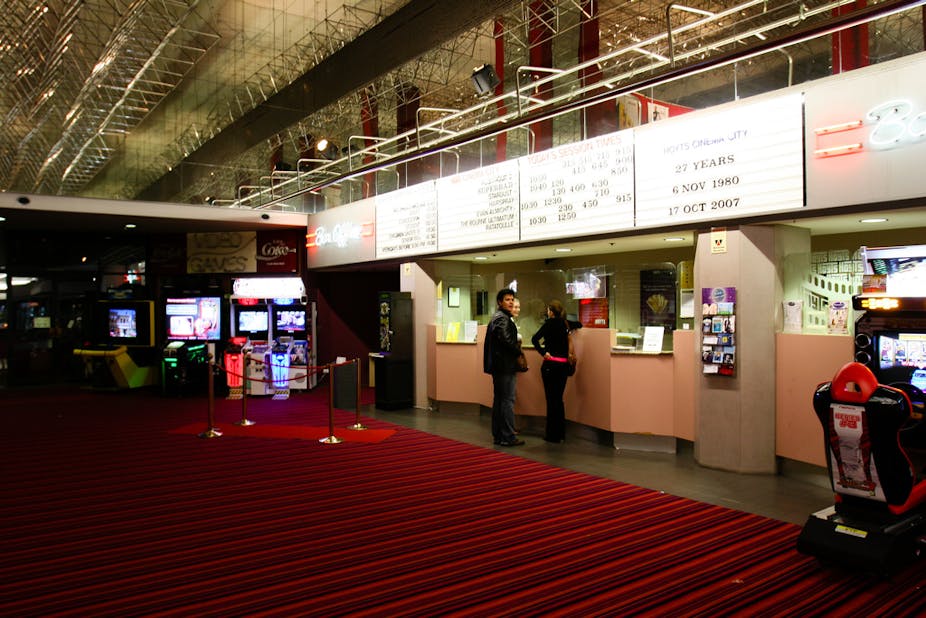Cinema company Hoyts Group is again considering listing on the stockmarket, tipped to take place sometime later this year. It’s expected that the float will be valued at around A$700 million.
The group has an impressive footprint, controlling about 18% of the approximately 2000 cinema screens in Australia. It edges out nearest rival Greater Union to command the largest slice of the market.
As well as its numerical supremacy, Hoyts also owns Val Morgan, the cinema advertising business which controls 95% of the Australian market. Last year, Val Morgan posted a 30% rise in revenue.
But a challenging landscape lies before the company.
If Hoyts is to maintain its reign as an entertainment giant and strongly position itself for this IPO, it will need to consolidate its existing offering, and move aggressively to find new revenue streams including – as it has already flagged – online video-on-demand.
Down and out in an internet age?
In an industry characterised by the roller coaster of big hits and huge flops, exhibitors have also had to ride out significant changes in consumer behaviour.
Australians are fast gaining a reputation for leading the world in film and television piracy.
In 2011/12, the number of times people visited the cinema reached an all-time low of around 6.8 visits per year per capita – down from a high of more than 11 visits per year in 1996 - the year when the internet first began to appear in Australian homes.
In amongst the news of the possible IPO was renewed discussion from newly-minted CEO Damian Keogh of Hoyts’ plans to launch their streaming service.
There is yet to be a major subscription video-on-demand (SVOD) success story in Australia. National operator Quickflix has struggled valiantly to survive the transition from online DVD rental to a focus on streamed content.
They’ve been busy creating strategic partnerships with platforms like Xbox and signing off licensing deals with distributors of like BBC Worldwide, HBO and Disney to shore up their catalogue for consumers.
However, the mixed fortunes of Quickflix isn’t stopping other operators, like Hoyts and specialist cinema operator Dendy from also readying themselves to enter the SVOD business.
No doubt Hoyts’ enthusiasm to move into this space has been fanned by the stunning rise of US streaming service Netflix.
The company is posting extraordinary growth both in profits and subscriber base.
In addition, it’s making high-profile moves into producing content with offerings like the award-winning House of Cards and the highly-acclaimed Orange is the New Black.
Although they’re yet to announce firm plans to launch in Australia, Netflix is no doubt gratified – as their competitors are perturbed – by the numbers of subscribers they are reported to already have here.
These Australians inhabit a legal grey area, having used proxy services to circumnavigate Netflix’s geoblocking to become paying customers.
The challenge for Australians companies moving into streaming will be to hit the mark on the key features which have arguably made Netflix a roaring success: low-cost, all-you-eat subscriptions and a broad and deep catalogue of content that will appeal to a wide demographic.
Show me the money
But it’s not a lost cause for the bricks-and-mortar cinema chains – yet. James Cameron’s Avatar heralded the return of 3D to the mainstream in 2009. The financial boost to cinemas has come in part from 3D commanding a premium-priced ticket.
And 3D films offer a cinema experience that’s difficult to replicate at home with a pirated copy of a film. While this hasn’t transformed rates of cinema attendance, it appears to have steadied the decline.
But 3D films are unlikely to be the enduring answer to exhibitors’ prayers. There’s evidence to suggest that the shine is wearing off 3D movies.
It’s unclear how much longer they’ll be able to keep their hold on a higher price point. Operators like Cineplex, the family-run Queensland chain, are positioning themselves as a low-cost entertainment option, offering 3D tickets at a much cheaper price as standard practice.
Nevertheless, the average ticket price paid by movie-goers still remains high.
Theatres have also increased their efforts to create a “premium” experience for audiences.
Chains now offers an “event” experience: “gold class” cinemas with larger screens, more comfortable seating, food and wine packages and promises of improved sound and picture experiences.
This means that despite falling attendance, the cinemas are able to hold on to their profits by increasing the unit price.
But how much longer will it be before the exhibitors’ bricks-and-mortar businesses start to finally succumb to the law of diminishing returns?
Hoyts’ CEO Keogh has made it clear. The growth opportunities for the company lie not in the expansion of real estate, but in adding to the value of their physical customer experience and in diversifying into digital delivery.
Australian audiences have proved themselves to be resourceful and determined to view screen content by whatever means possible – and at the price of their choosing. Businesses looking for success in the future landscape of cinema will face a tough time from these demanding consumers.

